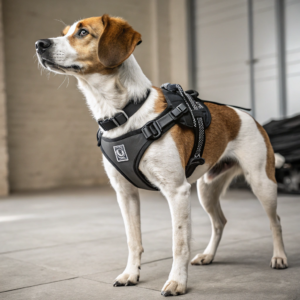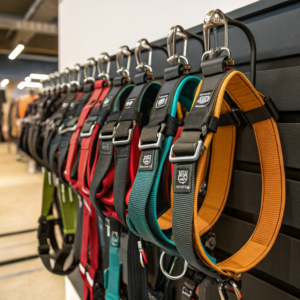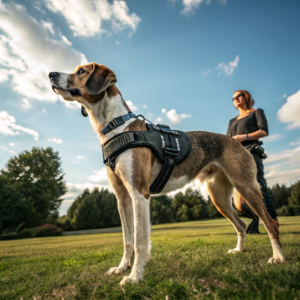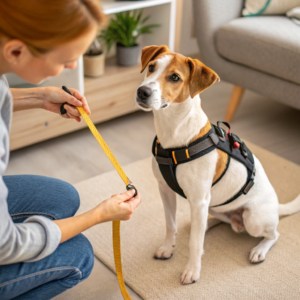How to Choose the Right Harness for My Dog?
Walking my dog used to be a daily struggle. The constant pulling hurt my shoulders, the choking sounds worried me, and I felt helpless as my pup lunged at every squirrel we passed.
**The right The right dog harness should match your dog’s size, behavior, and walking needs. Measure your dog’s chest and neck carefully, consider their pulling habits1, and decide between back-clip harnesses (for calm dogs), front-clip options (for pullers), or dual-clip designs for versatility and training purposes

I remember the frustration of trying multiple harnesses before finding the perfect match for my energetic Lab. The right choice transformed our walks from stressful tugs-of-war into enjoyable bonding time. Let me share what I’ve learned to help you make the right choice for your furry friend.
How to Pick the Right Dog Harness?
Standing in the pet store aisle, I felt completely overwhelmed by the endless harness options. Different styles, materials, and features made choosing feel impossible, and I worried about wasting money on something uncomfortable or ineffective.
**To pick the right dog harness, consider your dog’s behavior (pulling, anxiety, escape attempts), their body shape, and yourTo pick the right dog harness1, consider your dog’s behavior (pulling, anxiety, escape attempts), their body shape, and your walking goals

When I first started researching harnesses for my dog Cooper, I was shocked by how technical the whole process seemed. After some trial and error (and a drawer full of barely-used harnesses), I finally understood what features actually matter for different dogs and situations.
Selecting the perfect harness involves understanding the main harness types and matching them to your specific needs. Each design serves different purposes and comes with its own set of advantages. I’ve found that considering both your dog’s physical characteristics and behavior patterns is crucial for making the right choice.
The most common harness styles each serve different purposes:
| Harness Type | Best For | Key Features | Potential Drawbacks |
|---|---|---|---|
| Back-clip | Trained dogs, everyday walks | Simple design, comfortable | Limited control with pullers |
| Front-clip | Training, reducing pulling | Redirects momentum when dog pulls | Can tangle in legs if poorly fitted |
| Dual-clip | Versatility, progressive training | Multiple attachment options | Bulkier, more expensive |
| Step-in | Easy on/off, anxious dogs | Simple to put on | Sometimes less secure |
| Vest-style | Small breeds, dogs with sensitive skin | Distributes pressure evenly | Can cause overheating |
| Head halter | Strong pullers, precise control | Maximum steering control | Requires gradual introduction |
Material choices also significantly impact comfort and durability. During hot summers, I switch Cooper to a mesh harness that provides better airflow. For our hiking adventures, we use a more rugged nylon harness with reinforced stitching. Consider your typical walking conditions when selecting materials:
- Nylon: Durable and affordable but can chafe
- Mesh: Lightweight and breathable but less durable
- Neoprene: Padded and water-resistant but can trap heat
- Leather: Durable and adjusts to body shape but requires maintenance
Don’t forget to check for quality features like secure buckles, reinforced stitching at stress points, and reflective elements for night safety. I learned the hard way that cutting corners on quality often leads to faster wear and tear or even harness failure during walks.
What Kind of Harness is Best for a Dog That Pulls?
Before finding the right solution, walks with my energetic retriever were exhausting battles of strength. He pulled so hard that I dreaded walking him, worried about hurting his neck, and felt embarrassed by my lack of control when passing other dog owners.
**For dogs that pull, For dogs that pull, front-attachment (no-pull) harnesses are most effective as they redirect forward momentum1 sideways when the dog lunges forward

I tried four different harnesses before finding one that actually helped with Cooper’s pulling. The difference was immediate and remarkable. Instead of being dragged down the street, I could finally walk comfortably while gradually teaching him better leash manners.
Dealing with a dog that pulls requires understanding both the mechanics of control and your dog’s comfort. The right harness works as a training tool rather than just a restraint device, helping you communicate with your dog while maintaining control during the learning process.
Front-clip harnesses are often the first recommendation for pullers because they work with simple physics. When your dog pulls forward, the leash attachment point on their chest creates a sideways redirection rather than allowing them to use their full strength to move forward. This makes pulling less rewarding and gives you a mechanical advantage without causing pain.
For particularly strong or determined pullers, consider these specialized options:
| Harness Type | How It Works | Best For | Training Considerations |
|---|---|---|---|
| Front-clip | Redirects forward momentum | Most pullers, everyday use | Pair with positive reinforcement |
| Dual-clip with double-ended leash | Provides balanced control | Transition training | Gradually shift from front to back clip |
| Head halter | Controls head direction | Extreme pullers | Requires gradual introduction |
| Tightening harness | Applies pressure when pulling | Stubborn pullers | Use carefully to avoid negative association |
| Wide padded chest plate | Distributes pressure evenly | Power pullers | Prevents injury during pulling episodes |
I’ve found that no harness completely stops pulling on its own – consistent training is essential. The harness simply gives you the control needed to implement training effectively. Use the harness as a management tool while teaching loose-leash walking through positive reinforcement (rewarding when the leash is slack).
For Cooper, a combination approach worked best. We started with a front-clip harness to manage immediate pulling behavior while implementing structured training sessions. After a few months, we transitioned to a dual-clip model, using the front attachment in high-distraction environments and the back clip during calmer walks.
Remember that some dogs pull due to excitement, while others pull from anxiety or fear. Understanding your dog’s motivation helps you choose the right harness and training approach. I realized Cooper pulled mainly from excitement and lack of impulse control, so our training focused on calmness and attention exercises.
How Do You Know What Size Dog Harness to Get?
I’ve made the mistake of buying the wrong size harness multiple times. Too tight, and my dog was uncomfortable; too loose, and he escaped during a walk near a busy street – a terrifying experience I never want to repeat.
**To determine the correct To determine the correct harness size, measure your dog’s chest girth (the widest part behind the front legs), neck circumference, and weight. Compare these measurements to the manufacturer’s specific sizing chart1, as sizes vary between brands

Finding the perfect fit for Cooper took some trial and error. I learned that different brands have significantly different sizing standards, and that even within the "medium" category, measurements could vary by several inches. Taking proper measurements transformed our harness-buying success rate.
Proper harness sizing is crucial not just for security but also for your dog’s comfort and mobility. A poorly fitted harness can cause chafing, restrict movement, or allow escape. I’ve developed a systematic approach to harness sizing after making nearly every possible mistake myself.
The most important measurements for harness fitting include:
| Measurement | How to Measure | Why It Matters |
|---|---|---|
| Chest girth | Measure widest part of chest behind front legs | Primary sizing factor for most harnesses |
| Neck circumference | Measure around base of neck where collar sits | Important for overhead harnesses |
| Length | Measure from base of neck to start of tail | Relevant for full-body harnesses |
| Weight | Use bathroom scale (hold dog, then subtract your weight) | Secondary sizing factor |
Here’s my step-by-step process for getting the right measurement:
- Use a soft measuring tape (or string that you can measure afterward)
- Measure when your dog is standing in a natural position
- Take each measurement twice to confirm accuracy
- Add 1-2 inches to chest measurement for comfort (unless manufacturer advises otherwise)
- Record all measurements before shopping
I’ve found that different harness styles require different fitting approaches. For Y-shaped harnesses, chest and neck measurements are crucial. For vest-style harnesses, chest girth and length matter most. Step-in harnesses primarily use chest girth for sizing.
Weight recommendations on packaging can be helpful starting points, but they’re not reliable on their own. Cooper is a lean 50-pound dog but wears a medium in some brands and a large in others. Always prioritize actual measurements over weight guidelines.
Once you’ve purchased a harness, proper fitting is essential. For a correct fit, you should be able to slip two fingers (but no more) between the harness and your dog’s body at any point. Watch for signs of poor fit during use: redness, hair loss, chafing, or your dog showing discomfort when wearing it.
For growing puppies, I recommend adjustable harnesses with some room to expand, but be prepared to upgrade as they grow. I made the mistake of buying an adult-sized harness for my puppy, thinking he would "grow into it," only to have him slip out during a walk because it was too loose.
Conclusion
Choosing the right harness transforms walks from stressful to enjoyable. Consider your dog’s behavior, measure carefully, and match the harness style to your specific needs. Remember that the perfect harness provides comfort, control, and security while supporting your training goals.
-
Learning to read a sizing chart can help you choose the right harness, preventing discomfort and ensuring safety.
, measure your dog’s chest girth (the widest part behind the front legs), neck circumference, and weight. Compare these measurements to the manufacturer’s specific sizing chart, as sizes vary between brands. The harness should allow two fingers of space between the straps and your dog’s body while remaining secure.** ↩ ↩ ↩ ↩

